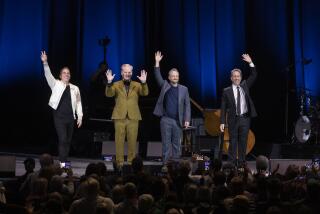Harold Ramis dies at 69; writer, director of successful film comedies
When Faber College was about to expel the misfit Deltas of “Animal House,” the rambunctious character Bluto Blutarski rallied them, but it was writer Harold Ramis who provided Bluto’s stirring words:
“What? Over? Did you say over? Nothing is over until we decide it is! Was it over when the Germans bombed Pearl Harbor? Hell, no! It ain’t over now, because when the going gets tough, the tough get going. Who’s with me? Let’s go! Come on!”
For a few comic beats, the downcast frat boys react with utter silence — exquisite moments that made one of Ramis’ funniest scenes even funnier.
Ramis, a grocer’s son who decided he wasn’t brave enough to be a professional comic but would be fine “lobbing in great lines here and there,” died Monday at his Chicago-area home of autoimmune inflammatory vasculitis, a rare disease that involves swelling of the blood vessels, his wife, Erica Mann Ramis, said.
He was 69 and had been battling the illness for four years.
A writer and director whose films grossed well over $1 billion, Ramis worked with and inspired the most successful comic actors in the U.S.
The late John Belushi, who played Bluto in “Animal House,” was a friend since the days they performed together in Chicago’s Second City improv troupe.
Judd Apatow, who directed “The 40-Year-Old Virgin” in 2005 and “Knocked Up” in 2007, interviewed Ramis for his high school radio station.
“He was the person that I wanted to be when I was growing up,” said Apatow, whose latest producing credit is “Anchorman 2: The Legend Continues.” “His work is the reason why so many of us got into comedy.… He literally made every single one of our favorite movies.”
Ramis had writing credits on such enduring movie comedies as “National Lampoon’s Animal House” (1978), “Stripes” (1981) and “Ghostbusters,” the 1984 hit in which he co-starred as the geeky, brilliant Egon Spengler, doctor of parapsychology.
Among the films he directed were “Caddyshack” (1980), “National Lampoon’s Vacation” (1983), “Groundhog Day” (1983) and “Analyze This” (1999).
Ramis’ first films were exuberantly thrown pies in the face of authority — Army drill sergeants, pompous college deans, country club dandies or anyone else who might profit from a comic takedown.
His later films, such as “Stuart Saves His Family” (1995), “Multiplicity” (1996), “Analyze This” and his “Bedazzled” remake (2000), were more introspective, reflecting what he described as his own blend of “existential psychology, Buddhism and progressive Judaism.”
Most of them were still hilarious.
“Groundhog Day,” in which a cynical TV weatherman seems to be trapped in an endlessly repeating 24 hours in Punxsatawney, Pa., expressed one man’s desperate search for meaning, he told NPR’s Terry Gross in 2005.
“There is no universal meaning to life that applies now and for always, for each and every person,” he said. “Our job — and it’s a tough job — is to figure out what it all means and to fulfill a personal destiny that we each figure out for ourselves.”
Dan Aykroyd, Ramis’ costar in “Ghostbusters,” alluded to his old friend’s intellectual questing in a statement Monday: “May he now get the answers he was always seeking.”
Born in Chicago on Nov. 21, 1944, Harold Allen Ramis graduated from Washington University in St. Louis. He worked seven months in a psychiatric ward and briefly taught at a school in one of Chicago’s toughest neighborhoods before plunging into his career in entertainment.
In the mid-1960s, he freelanced arts stories for a Chicago newspaper and later became an editor at Playboy, where he ran the jokes page.
Meanwhile, he started performing at Second City.
“The moment I knew I wouldn’t be any huge comedy star was when I got onstage with John Belushi for the first time,” he told the Chicago Tribune in 1999. “When I saw how far he was willing to go to get a laugh … how physical he was, throwing himself literally off the stage, taking big falls, strangling other actors, I thought: I’m never going to be this big. How could I ever get enough attention on a stage with guys like this?”
His ultimate solution: writing and directing, with some occasional, mostly secondary screen roles thrown in for fun. In Apatow’s “Knocked Up,” he was cast as Seth Rogen’s father because, as Apatow said, “we all saw him as the dream dad.”
Ramis worked in New York with Belushi and Second City cast member Bill Murray (who would collaborate with Ramis on six movies) on “The National Lampoon Radio Hour.”
They and Gilda Radner also performed in a National Lampoon stage show produced by Ivan Reitman, who went on to produce “National Lampoon’s Animal House” and to direct such Ramis scripts as “Meatballs,” “Stripes,” “Ghostbusters” and “Ghostbusters II” (1989).
“Animal House” was Ramis’ Hollywood breakthrough. Ramis and co-writers Doug Kenney and Chris Miller swapped stories of their own fraternity days — Ramis was in Zeta Beta Tau — and enhanced them, as Ramis told NPR, with “all the college apocrypha that we knew.”
All of them had trolled women’s colleges for dates. None had hatched schemes to meet a dead girl’s grieving friends, as Tim Matheson’s “Animal House” character did when he saw a story in the Emily Dickinson College newspaper headlined, “Sophomore Dies in Kiln Explosion.”
As characters and story lines came to life, they each wrote a third of the script. Then each had a chance to rewrite the others’ work, “so each of us had input on each section of the film.”
Ramis’ first directing effort came two years later with “Caddyshack.”
Ramis hoped to work with Don Rickles but was intrigued with Rodney Dangerfield after seeing him on “The Tonight Show,” he told Variety in 2000.
“Dangerfield was so excited,” he said. “He had no conception of how movies were made. There was ‘Rolling,’ ‘Speed,’ and ‘Action,’ and Rodney looked at me. I said, ‘Action.’ He looked at me. Then he said, ‘Do you want me to do the bit?’ I said, ‘Do the bit.’ ”
After the collapse of his first marriage and the flop of his 1986 comedy “Club Paradise” (with greedy developers as the institutional villain), Ramis immersed himself in Zen Buddhism.
“It’s my shield and my armor in the work I do,” he said.
More recently, Ramis directed “The Ice Harvest,” a dark comedy set in Kansas strip clubs that was released in 2005. His most recent offering, “Year One,” a biblical-era comedy with Jack Black and Michael Cera, was released in 2009.
In 1996, Ramis, a hometown boy at heart, moved back to Chicago with his family.
Life in Los Angeles, he said, was like life in high school. “Am I popular? Am I cool? Who’s the in crowd? How do I get into that party? These are not things I ever wanted to worry about.”
Besides his wife, he is survived by daughter Violet Stiel; sons Julian and Daniel Ramis; two grandchildren; and a brother, Steve.
Times staff writer Elaine Woo contributed to this report.
More to Read
Start your day right
Sign up for Essential California for the L.A. Times biggest news, features and recommendations in your inbox six days a week.
You may occasionally receive promotional content from the Los Angeles Times.







